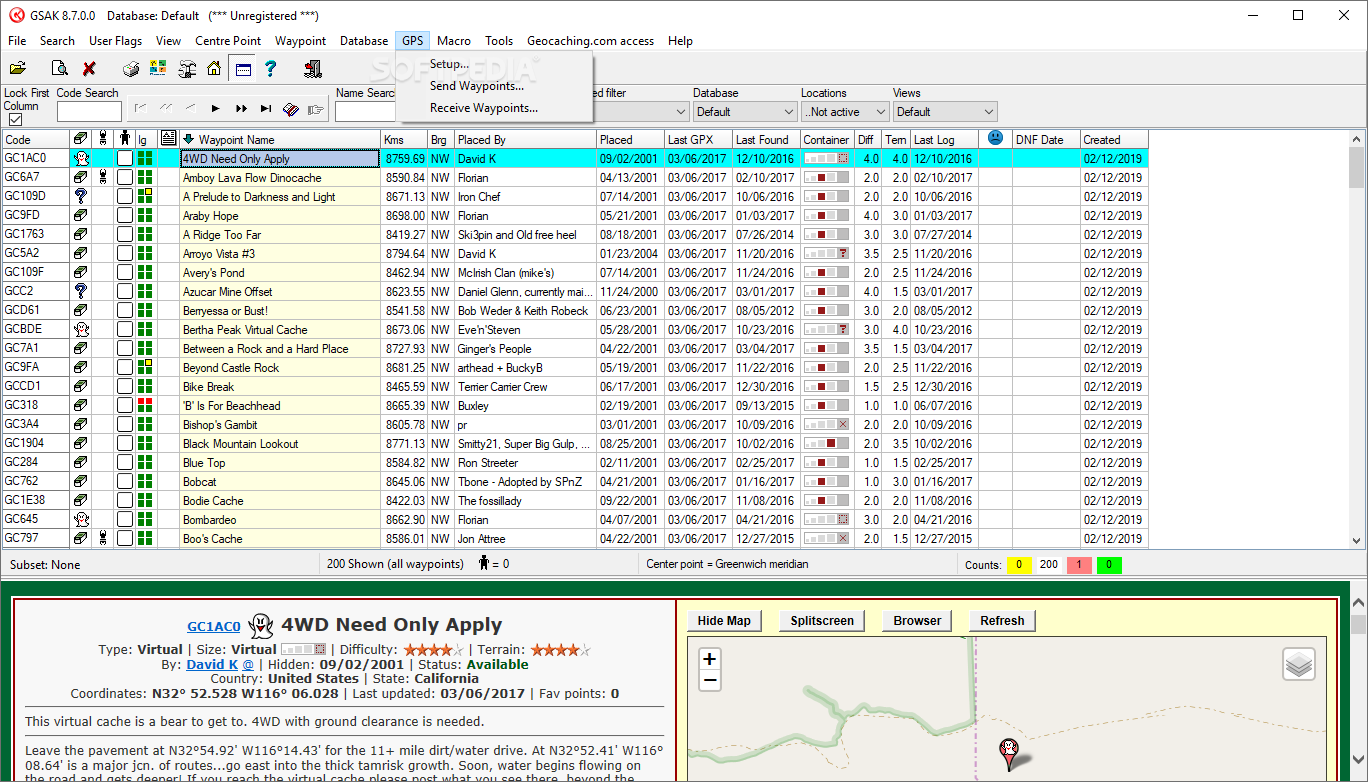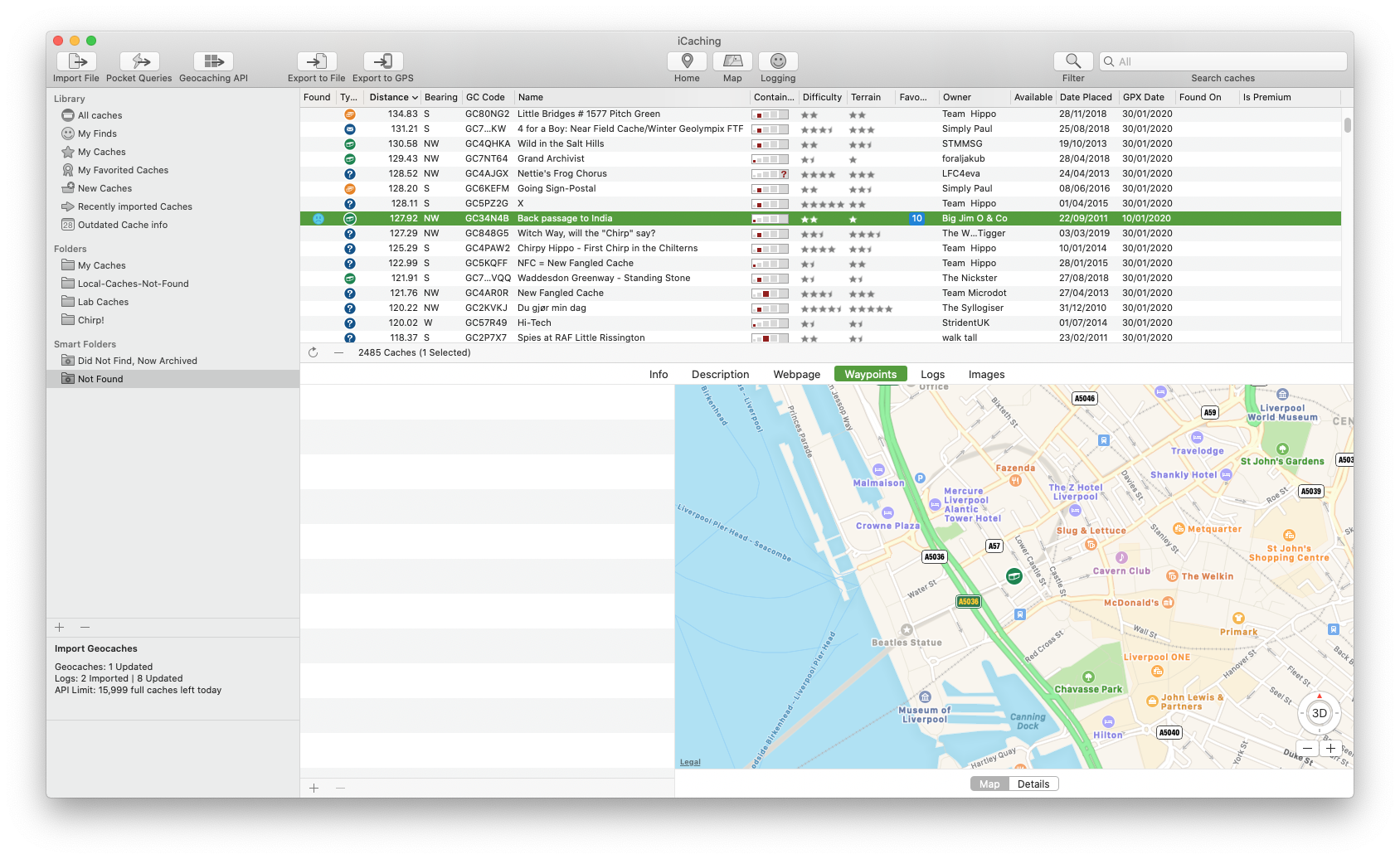This is not pretty and cannot be done realtime, yet, But I haev found a way to convert Vistumbler data into a variety of Nav File formats (including MSTRIPS)...
One of my other hobbies is a sport called Geocaching (google it). Essentially is using GPS to locate 'caches' placed by other geocachers and posted as waypoints. Many GPS related tools have been created to help in this with the most popular being GSAK (Geocaching Swiss Army Knife)
GSAK Geocaching Swiss Army Knife for OziExplorer. Memory-Map navigation software for hand help maps. TUMONZ The ultimate map of New Zealand. GeoBuddy Geocaching software with built-in topo maps and aerial photos. Mapwel create vector maps for Garmin receivers. GeePeeEx Editor Garmin POI creation and editing. GPX2SHP Convert GPX to ESRI. ICaching is an alternative on Mac, but while I have it installed, I've never really used it. So can't compare its functionality to what GSAK can do for you. But depending on what you use GSAK for, I find project-gc.com a better, cheaper and easier to use alternative than GSAK. It's completely web based, so independent from whatever OS you use.
http://www.gsak.net/. Among the tools available in GSAK is a a file conversion utility that converts either .LOC or .GPX waypoint files into a large number of other GPS/MAPPING Navigators including:
CacheMate PDB File
CSV or TXT
Custom Format
Delorme Topo Usa, Street Atlas Plus, etc
Fugawi TXT File
 Garmin POI file
Garmin POI file GPX/LOC File
HTML Files
Lowrance USR File
Magellan eXplorist and SD Card
Mapsend MPS file...
MapSource File
MapTech eXchange Format MXF File
Memory Map CSV file
Microsoft Streets and Trips text File
Gsak For Mac 2020
National Geographic TOPO! TPG File
OziExplorer WPT File
Pocket Streets PSP File
Street Atlas File
TomTom POI file
The process is a little bit involved but not unbearable.. Export Vistumbler data as a .GPX file (remember where you parked it) then open GSAK then under File, select Load GPX/LOC/ZIP then the GPX file you are wanting to import. Gsak will then build the database... Since it is not specific to the actual data exported by 'tumbler , it will list ssid, mac, and coordinates. It will not translate the GPS track just waypoints
More to come as they are asked
ATTENTION! This guide is a few years old! I haven’t used GSAK on my mac in a very long time since I mostly use Project-GC and iCaching instead. In other word I can’t promise this guide will work!

I’ve been searching the web for a guide how to get GSAK to run on OS X, but since i didn’t found anyone I decided to write one myself, so here you go. 🙂
As you know GSAK is not meant to run on OS X so you probably might experience some crashes and some bugs. If you run into any bugs, please feel free to let me know in a comment below. 🙂
What you need is:
- A Mac running OS X (duuuh! 🤪)
- Wine and WineBottler
- GSAK8
- A computer running Windows (If you have Parallels and Windows installed on your Mac this works fine too)
- A USB memory
- And a cup of coffee or two
Step 1 (Download and install WineBottler):
Go to http://winebottler.kronenberg.org/ and download WineBottler 1.4.1.6 Stable.
Open the DMG-file and drag both Wine and WineBottler to your Application-folder.
Step 2 (Download GSAK):
Go to http://gsak.net/ and download GSAK Version 8.3.0.
Gsak Macro Api
Step 3 (Installing GSAK using WineBottler):
Start WineBottler (if you get asked to download the latest version click Skip this version or Remind me later).
Click on Advanced
Click on select File… and browse and choose the GSAK installer that you’ve downloaded.
Check the box ‘Bundle’ (Include Wine binaries, so the app can run without prior install of Wine.
Under ‘Identifier’ you can type “GSAK8”
It should look like this:
Click on ‘Install’.
Enter “GSAK8′ as filename and choose where you want to save the file (for example on your Desktop) and click on ‘Save’.
Follow the GSAK installation instructions.
When you get near the end of the installation uncheck every check box so it looks like this:
Click ‘Next’
Uncheck the ‘Launch GSAK’-box.
Click ‘Finish’
Now you will be asked to choose which file that is going to run when you dubble click the created application.
Choose ‘gsak.exe’ so it looks like this:
Click on ‘OK’
Step 4 (Authenticate GSAK with geocaching.com):
Here it gets a little tricky cause GSAK running under Wine won’t authenticate with geocaching.com, it will just freeze if you try to sign in on geocaching.com.
So here is what you need to do:
Install GSAK on a computer running Windows (it works fine if you are running Windows under Parallels on your Mac).
When GSAK is installed and running:
Click on ‘Geocaching.com access->Get another access token’
Enter your username and password, don’t forget to check the ‘Keep me signed in’-checkbox.
Click ‘Sign In’ and then ‘Allow access’
GSAK now has access to your geocaching.com-account. You can see this by clicking on the menu ‘Geocaching.com access’ and now your geocaching username should be listed on the bottom of then menu.
Gsak For Mac Free
Click on File->Backup
Click on ‘Select all Databases’ and check the box ‘Save GSAK Settings’.
Choose your USB memory as the location to save the backup file and then click ‘Backup’
Insert your USB memory in your Mac and start GSAK.
Click on File -> Restore
Choose your backed up file on your USB memory (you probably need to browse to: Z:Volumes<your USB drive>).
Click on ‘Select all Databases’
Check ‘Restore all GSAK Settings’
Check ‘Remove absolute paths for called macros (recommended)’
Click on ‘Restore’ and then click ‘Yes’ and after a little while click ‘OK’.
If every thing went right your GSAK on OS X now should be authenticated with geocaching.com. To verify this click on ‘Geocaching.com access’ and on the bottom of the meny you should see your geocaching username.
Step 5 (Fix the icon)
(This step is very optional and if you don’t care about how your icon look you can jump to step 6)
Now you got GSAK running on your Mac. But as you see it has a quite poor icon.
To fix this follow the instruction below:
Click here to download the GSAK icon.
Open the gsak.ico with Preview on your Mac.
Click on Edit->Copy (or just push CMD+C on your keyboard)
Right click on your GSAK8-app and choose Get info (or just click it once and push CMD+I on your keyboard).
Click on the icon in the upper left corner and then click Edit->Paste (or just push CMD+V on your keyboard).

Gsak For Mac
Close the window by clicking on X in the upper left corner.
Now you should have a quite nice icon for your GSAK-app. 🙂
Step 6 (Moving GSAK to your Application-folder)
Just like the title says, it’s time to move your GSAK-app to your Application-folder. In other words just drag and drop it to your Application folder and then you are good to go. 🙂
Feel free to give me feedback by commenting below.